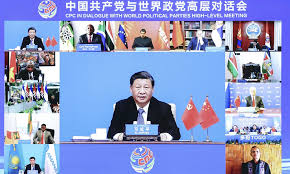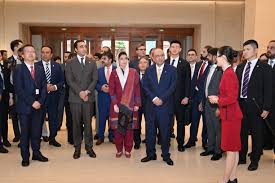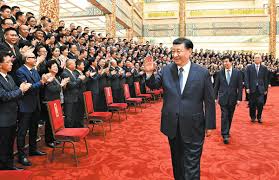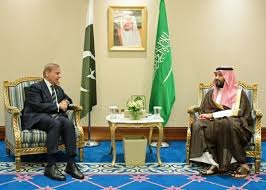China’s Global Civilization Initiative: A Backing for BRI in a Divided World?

In the contemporary world marked by geopolitical divides, where cultural identities and sovereignty are key debates, China’s Global Civilization Initiative (GCI) is a persuasive strategy to win popular support across the globe.
“All civilizations created by human society are splendid. They are where each country’s modernization drive draws its strength and where its unique features come from.” (Xi Jinping)
In the contemporary world marked by geopolitical divides, where cultural identities and sovereignty are key debates, China’s Global Civilization Initiative (GCI) is a persuasive strategy to win popular support across the globe. President Xi Jinping introduced this initiative on March 15, 2023, at the CPC in dialogue with the World Political Parties High-level Meeting. The GCI serves as a compelling strategy in counteracting the perceptions of Chinese neoimperialism and expansionism, associated with Belt and Road Initiative (BRI), through cultural exchange and cooperation in divided world.
Delivering a keynote address at the meeting, the Chinese president stressed that tolerance, coexistence, exchanges, and mutual learning among different civilizations play an irreplaceable role in advancing humanity’s modernization process and making the garden of world civilization flourish, as the future of all countries is closely connected nowadays. The introduction of this initiative not only focuses on the projection of Chinese soft power but also supports redefining of the global discourse on culture and identity. In order to perfectly understand its relevance, it is important to understand that how this initiative can complement China’s strategy in contemporary world and what impact it can have on BRI.
Chinese GCI: Clash of Civilizations or Harmonious Coexistence?
As China is rising and its global influence is expanding, its approaches to cultural diplomacy are also under tight scrutiny. This critical approach by the world powers towards China highlights the importance of cultural influence in global power dynamics. The role of cultural and civilizational factors in the making of hegemonic structures has been the subject of intense debate among scholars. Samuel Huntington, in his book “Clash of Civilizations,” argues that cultural and religious identity would be a key driver for conflict in the post-Cold War period. Contradictory to this view, Amartya Sen finds that identities are complex and sometimes overlapping, rather than a fixed entity; hence, he criticizes this essentialist view, advocating for a pluralistic perspective in the understanding of identity.
Furthermore, Professor Fei Xiaotong, the author of ‘From the Soil,’ says “各美其美,美人之美,美美与共,天下大同,” which means, “Appreciate the beauty in one’s own culture and the beauty in others, and the world will become a harmonious whole.” This ideology offers a strong foundation for understanding the essence of China’s Global Civilization Initiative (GCI). It emphasizes on enhancing the cultural understanding and dialogue among different cultures and civilizations, which is technically a refutation to the Huntington’s predictions that a clash among civilizations is inevitable. By making these efforts, China wants to project itself as a peace-loving leader advocating for mutual understanding and respect among different cultures. From the strategic standpoint, the projection of this image will nullify Western criticisms of its strategy in the global arena.
Chinese Society has always been influenced with the Confucian ideology. The Confucian values such as harmony, respect for traditions, and the emphasis on the collective well-being, lies at the heart of Chinese society and Global Civilization Initiative (GCI). This ideological ground is key to unlocking the Chinese vision of a multipolar world where diverse civilizations may coexist peacefully instead of clashing. In this way, this initiative counteracts the Western narrative of portraying China as a threat to the world order. By presenting its approach as one of cultural exchange and mutual respect for others, China is trying to create its image as a benevolent power in the world. It aims not only to assert its soft influence but also to reshape global perspectives around its vision of global governance.
In the contemporary world, where the rise of China is creating a sense of ‘security dilemma’ for the Western world, especially the United States and its allies, as they believe that China’s BRI is one of the major instruments for its political and strategic maneuvers. It is often portrayed as a debt trap or Neo-imperial trap aimed at fostering Chinese expansionism by expanding its roads and railways networks, while controlling the economic statecraft of developing states in this era of geoeconomics. Critics argue that China’s growing influence threatens the sovereignty and cultural identity of smaller nations and undermines existing global norms. Meanwhile, China portrays the BRI as a flagship project that will bring development and connectivity across Asia, Europe, and Africa. Moreover, through BRI, China aims at fostering the economic partnerships by building trade routes, while also leveraging the cultural exchange and civilizational dialogue.
Strategically, the GCI is a well-crafted response to all the assertions made against China. From the lens of GCI, the investments in infrastructure projects of different countries is a compelling strategy aiming to ensure the collective well-being, because it is a driver for shared growth and development. In simple words, the GCI complements BRI, by portraying it as a form of symbiotic relationship (positive-sum game) rather than exploitation. Therefore, it supports China by countering the narratives regarding neo-imperialism and expansionism, while persuading the world that Chinese actions are collaborative, not coercive.
Furthermore, the success of BRI not only lies in the expansion of roads, railways, or maritime routes across the world, but it also demands the positive projection of Chinese culture, ideology and values. Here the GCI may help in enhancing the cultural understanding and creating a tapestry of shared civilizational narratives. Collectively, all these efforts will reshape the global narrative in China’s favour, while enhancing the Chinese posture in world politics.
In addition, this initiative also serves the function of addressing the challenges posed by globalization to cultural identities. It serves as a model offering a holistic approach to ensure the peaceful and harmonious coexistence, by respecting the cultures, values, and norms of all countries. In technical terms, this initiative invalidates the Western narrative that China is doing efforts for homogenizing its culture.
Conclusion
In the contemporary world that is divided into varied cultures and civilizations, the GCI aims at redefining the notions of cultural engagement on the world stage. This fragmentation somehow sets the ground for ‘Clash of Civilization’. Therefore, by leveraging GCI, China is trying to set a stage for fostering a dialogue among civilizations for creating harmonious society. Additionally, this initiative serves the function of a persuasive strategy countering the claims linked with BRI such as Chinese expansionism, neo-imperialism, and cultural homogenization. The success of this effort will enhance China’s ability to exercise its soft power and strengthen its global posture as a benevolent force in international relations. As a result, it will not only provide China with global popular support in creating a harmonious global landscape, but will also support its BRI.





